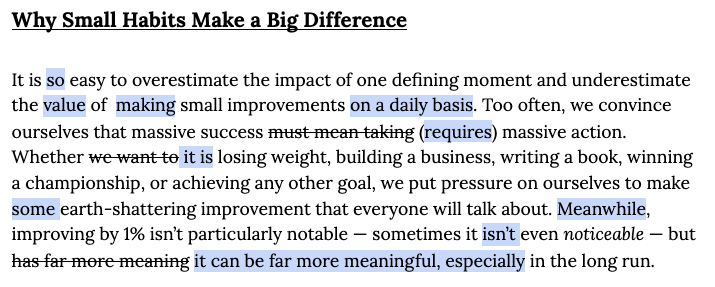|
In his adolescence, Benjamin Franklin was acutely aware of his poor writing ability, and wanted to do something about it. And so, he gathered up copies of his favourite periodical, The Spectator, and began reproducing parts of it from memory, along with scraps of notes that he had taken. By engaging in this method, Franklin had unwittingly stumbled upon one of the most effective practice strategies ever conceived. It can be applied to any craft, and generates remarkable results. Combined with computers and basic word processing software, you can use this strategy to dramatically improve your writing skills, and accurately document your progress. Like a football player watching game tape or a chess master reviewing an endgame, Ben Franklin's technique allows you to see where your writing falls short through immediate feedback, and provides you with more elaborate mental representations of good writing that you can then use to write better sentences, emails, essays, and books. Let's explore the method, updated to incorporate modern technology, that will unlock your latent power as a writer. Taking Notes Franklin would begin by writing down, in a few words, the gist of each sentence from a passage. This would serve as a signpost for him to reconstruct the sentence later on. You can speed up this process even further by only writing a handful of abbreviated words. Recently, I have been using James Clear's Atomic Habits as a source text for this technique. Let's take this passage as an example: It is so easy to overestimate the impact of one defining moment and underestimate the value of making small improvements on a daily basis. Too often, we convince ourselves that massive success requires massive action. Whether it is losing weight, building a business, writing a book, winning a championship, or achieving any other goal, we put pressure on ourselves to make some earth-shattering improvement that everyone will talk about. If I am moving quickly, I will only write down short hints that point to what each sentence says. They might look like gibberish to anyone else, but they only need to make enough sense to me to help recreate each line. For example: I invite you to try working through 1 or 2 pages of a book or article that you want to emulate. Once you have condensed the passage into key words and ideas, set aside your notes for the day, and revisit them when you are ready for a challenge. Recall + Reproduce Recalling the details of the text and attempting to reproduce them accurately is at the core of Franklin's exercise. Using the condensed notes as clues, Franklin would try to replicate the style and structure of The Spectator without looking at the original writing. Research shows that using active recall when reading or studying helps significantly improve retention and understanding. With writing, the process yields similar results. By attempting to access the information that you read previously, you strengthen neural connections responsible for long-term memory and learning. This part is not easy. There will be mistakes. But, the process of reaching and failing is vital to the learning process. I have found that trying to express the spirit of each sentence, and focusing less on capturing the exact wording, often produces better results. I also recommend using a Pomodoro timer to make sure that you don't exhaust yourself during this part. Compare + Highlight Errors This stage is where you realize just how many mistakes you have made in the previous stage. It is eye-opening, and presents the biggest opportunity for progress. Over time, you can learn not only to value the negative feedback, but to associate the effort process with your internal dopamine reward systems. Here is the passage from Atomic Habits that I attempted to recreate, along with the errors I made. Highlighted text was missing from my recall session, while the strikethrough text is what I included that wasn't correct: This is one of the best deliberate practice sessions that I've had. Many of the other passages I have used are filled with even more errors and inaccuracies. Once you have gotten to this stage, pay close attention to where you went astray. What is the original sentence structure like? What words did you miss, or include that weren't in the selected passage? How does the author's style differ from yours? Which 80% of errors could you fix with 20% effort? From my experience using this method, I've noticed that I overcomplicate my writing, using too many big words where simple, spare language will do. I've also noticed that I use pronouns like "we" too much, instead of addressing the reader with "you", which is more direct and effective. Collect your mistakes, and reflect on them. They are what will help nurture your capability as a writer. Iterate Doing this exercise once or twice might help you identify a few key pitfalls in your writing. However, the true benefits of this practice come from repetition and honing the process. There is a reason I consider iteration to be a key mental model. The more you use the Benjamin Franklin Method, the more refined the method becomes, and the more you get out of it. Final Thoughts Writing is not a god-given talent that some people have and some don't. It is a skill like any other, and can be developed best through intentional practice. The Benjamin Franklin Method gives you a framework to begin improving right away. However, it requires effort, discomfort and openness to being wrong repeatedly. In a world where most of the advice offered to aspiring writers is to simply "read more", this strategy is an invaluable resource that will quickly set you apart from the competition. Comments are closed.
|




 RSS Feed
RSS Feed
